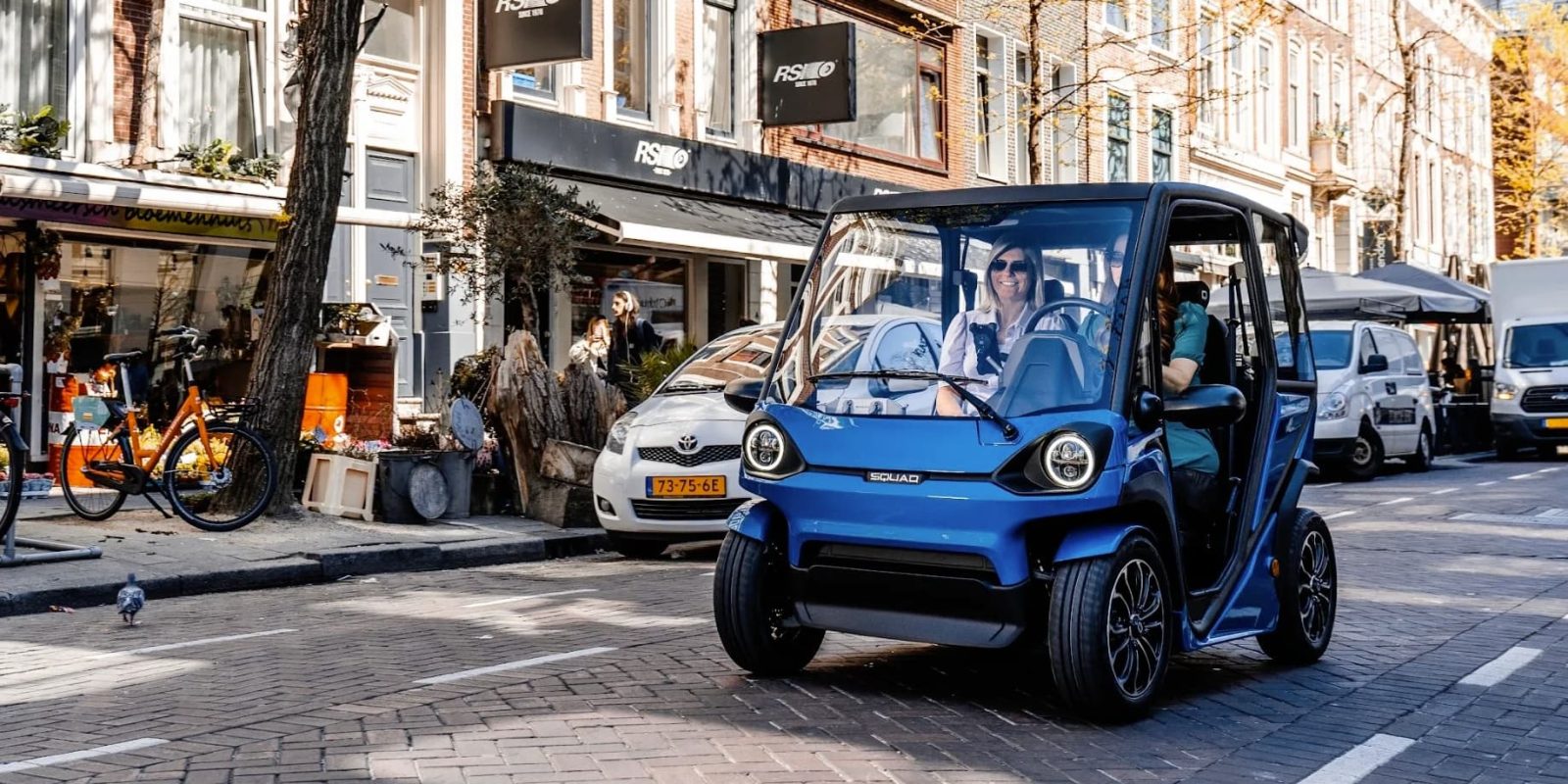Low-cost tiny electric cars like these could be the next big thing

It’s true that prices for many leading full-size electric cars have dropped slightly in the last few months. But even a $50,000 Tesla is still much harder to afford than an electric micro-car that can cost a quarter of the price. Those smaller electric tiny cars, NEVs, and LSVs also come with big advantages over their full-size cousins, saving more than just cash.
The post Low-cost tiny electric cars like these could be the next big thing appeared first on Electrek.
It’s true that prices for many leading full-size electric cars have dropped slightly in the last few months. But even a $50,000 Tesla is still much harder to afford than an electric micro-car that can cost a quarter of the price. Those smaller electric tiny cars, NEVs, and LSVs also come with big advantages over their full-size cousins, saving more than just cash.
Of course, that doesn’t mean that electric tiny cars are for everyone. They’re mostly suited to urban areas, beach communities, planned neighborhoods, and other areas without high-speed roads.
If you regularly use your electric car to drive a few states over, an electric micro-car simply won’t cut it for you. But for people who live in a densely populated area or who drive only a few dozen miles per day (i.e., most people in the US), an electric micro-car could do the trick while saving money, energy, emissions, and more.
What are electric micro-cars?
First of all, there’s no good definition that encompasses all of these small format electric vehicles. There’s not even a single good name. Micro-cars, mini-EVs, tiny cars, NEVs (neighborhood electric vehicles), LSVs (low-speed vehicles), and other names add to the confusion in this burgeoning industry.
At their core, most of these vehicles are technically LSVs, at least in the US. That’s the only federally defined term for the majority of these vehicles. It puts them in a class of smaller vehicles limited to 25 mph (40 km/h), and sets them aside as a street legal class of motor vehicles, at least if they meet a stringent set of production and manufacturing requirements and remain on roads with speed limits at or below 35 mph (56 km/h).
Terms like NEV (neighborhood electric vehicles) isn’t actually an official vehicle class, but rather just a loosely defined colloquial term for smaller and lower-powered EVs.
Many people think of golf carts when they think of NEVs, but those technically aren’t LSVs because they usually can’t reach the minimum required 20 mph to fit into the LSVs class, nor are they produced to LSV safety or manufacturing standards, such as having a VIN on file with the NHTSA (National Highway Traffic Safety Administration). Even so, while golf carts are not federally regulated to achieve street legal status, many US cities have created their own local ordinances to allow them to operate on certain roads. Towns such as Peachtree City, Georgia, have become famous for their thousands of golf carts that share the roads with larger vehicles as well as make use of mixed-use paths where cars aren’t allowed.
The European Union has their own set of electric micro-car rules that classify such vehicles into L6e and L7e categories that allow for higher speeds. These vehicles, which are considered either light or heavy quadricycles depending on their class, are already produced and sold by major European car makers like Citroen, Renault, and others.
Why would someone want an electric low-speed vehicle (LSV)
When it comes to LSVs, tiny cars, or whatever you want to call them, their smaller size offers big advantages.
First of all, they are much more affordable than most full-size electric cars, while still offering many of the major benefits of electric cars. Prices can start as low as $10,000 for an electric LSV, compared to most electric cars that cost several times as much.
The Eli Zero, a crowdfunded micro-electric vehicle coming to both the US and Europe, is expected to begin EU deliveries soon with a price of around US $12,000.
Despite that low purchase price, the Eli Zero still has a surprising number of features that make it feel like a “real” car, not a souped-up golf cart. The Eli Zero’s accoutrement list includes features such as a 70 mile (120 km) range, 2.5 hour charge time with on-board charger, regenerative braking, keyless start, heating & air conditioning, and optional power steering/power brakes.
I’ve driven an Eli Zero in both the US and Europe, and I can tell you firsthand that it feels much more like a “real” car than you’d expect.
You can take a quick look at it from my test ride last year in the roundup video below (start at the 4:00 mark for the Eli Zero).
While the Eli Zero is a two-seater and would be great for single drivers or couples living in cities, many LSVs are oriented toward families.
New LSV startup Wink Motors offers a lineup of four-seater LSVs starting at under US $10,000. With both coupe and four-door options, the small vehicles still provide enough seating for parents and two kids, plus plenty of cargo space in back. Some models have a fold-down rear bench that provides even more cargo space when only traveling with occupants sitting up front.
As Wink Motors founder Mark Dweck explained to Electrek:
Wink’s vehicles were purpose-built for urban use, meaning that four seats allows an entire family to go out together without needing a much larger car that would be harder to park or even pay for. We made sure to include enough cargo space for grocery shopping or other errands, and we even have solar powered models with roof-mounted solar panels for apartment residents that don’t have a place to plug in to charge at home. In our opinion, Wink’s vehicles are just cuter and more fun than a big car too.
While electric bikes and e-scooters are quickly becoming the dominant alternative personal electric vehicles in cities due to their small size and hyper affordability compared to electric cars, they still have some key drawbacks. Their exposed design means fewer people want to use an e-bike or scooter in the rain or cold weather, and they can be more vulnerable to theft (both the vehicle itself or personal belongings).
LSVs, on the other hand, are usually enclosed and thus can offer heating or air conditioning, and they lock to protect valuables left in the vehicle. It’s also harder to throw an entire LSV in the back of a truck and drive off, unlike an e-bike.
LSVs offer many other advantages beyond their low purchase price. They use significantly less energy than both electric and combustion engine cars, reducing fuel cost. They take up less space and are easier to park, which is especially important in urban areas with limited parking spaces. They have better visibility and thus make it easier to see pedestrians, curbs, bollards and other obstacles.
And last but not least, they’re often more fun to drive. They easily turn heads due to their novel appearance, and some of the quirkier or wilder designs wouldn’t look out of place at a car show.
LSVs are great for utility use in addition to personal vehicles
While the Wink vehicles above are more suited for couples or families, some LSV makers are targeting utility industries instead.
Texas-based AYRO recently revealed an electric mini-truck known as the Vanish with the payload capacity of a typical pickup truck, but at a lower cost and easier use for fleet operators.
The company’s CEO Tom Wittenschlaeger explained to Electrek that the Vanish brings the accessibility advantages of LSVs to more work-oriented customers:
AYRO’s latest innovation is built primarily for use in fleets in organizations ranging from university campuses and airports to resorts and golf courses. It is a utility low-speed electric vehicle intended to improve upon the foundation established by other EV-driven products in the fleet management industry today. LSVs, like the AYRO Vanish, are ideal vehicles for supporting last-mile delivery, micro distribution, and other campus or facility needs.
Fleet managers from these types of industries among others are struggling to maintain aging vehicle fleets and manage fuel costs. The AYRO Vanish can replace multiple aging vehicles while also meeting an organization’s sustainability goals. This low-speed electric vehicle fills the gap between full-sized trucks and small utility or golf carts. With the payload capacity of a pickup truck, it’s still compact enough to navigate narrow pathways and double doors. The Vanish also offers multiple payload configurations so not only can it replace aging fleet vehicles, but it also can be a versatile solution for a variety of purposes ranging from flat bed, utility bed, and even van and food box vehicle needs.
Do electric tiny cars have enough range?
The range of LSVs varies considerably, depending on their battery size and power level.
Generally speaking, most LSVs have a minimum range of at least 30 miles (48 km), though many have 2-3x that range.
According to the DOT, over 50% of personal vehicle trips in the US are less than 3 miles (5 km). That means that a heavy, expensive electric car with 300 miles of range is overkill most of the time.
While a 25 mph (40 km/h) vehicle with 40 miles (64 km) of range probably won’t take you to the next state over (unless you live right on the border), their ranges are usually more than enough for cities and communities where they are designed to operate.
Are LSVs and electric micro-cars safe?
Safety is one of the most important aspects of automotive transportation, and rightfully so. Cars are a leading cause of death. Last year 1.35 million people died on roadways worldwide. In the US, cars are often either the first or second leading cause of unintentional injury deaths (when second they come in behind accidental poisonings, be careful out there).
Suffice it to say that cars are dangerous. But they’re not just dangerous for drivers. They’re also dangerous for passengers and pedestrians too.
When it comes to LSVs and other tiny electric cars, there are safety advantages and disadvantages. LSVs have certain safety requirements such as DOT-approved seat belts, visibility requirements such as lighting, backup cameras, and other mandatory equipment. But they are not held to the same stringent safety requirements as full-size cars, such as not requiring air bags or having to pass crash tests. That’s part of how they can be so much more affordable. Building a car that can protect its occupants driving off a 250 foot cliff is impressive, but it results in a two-and-a-half ton $50,000 tank.
While LSVs are not held to the same stringent safety standards, many LSVs makers go above and beyond the minimum requirements.
I spoke about LSV safety with Paul Vitrano, the SVP and chief legal & policy officer at Waev, the company that manufactures the GEM micro-EV (that you might remember as the Polaris GEM from before it was spun off along with other light EVs into the Waev brand).
As Vitrano explained:
LSVs such as GEM are required to meet a suite of safety standards. When the National Highway Traffic Safety Administration created the LSV class nearly 25 years ago, it recognized both the utility of smaller, lower speed vehicles and the necessity of safety features tailored to the vehicles and use-cases. GEMs are certified to Federal Motor Vehicles Safety standards for lighting, turn signals, mirrors, braking, windshields, rear visibility, seat belts and backup camera.
Perhaps the biggest safety advantage of LSVs though is their speed. Lower-speed travel is safer for vehicle occupants and is significantly safer for pedestrians, which is a major concern in crowded cities that give up most of their public space to cars. According to the United States Department of Transportation (USDOT), “Speeding increases both the frequency and severity of crashes, yet it is both persistent and largely accepted as the norm amongst the traveling public.”
The danger to others is even more pronounced. Figures provided by the USDOT show that a pedestrian hit by a vehicle traveling at 23 mph (37 km/h) has just a 10% risk of death, but that increases to a 50% risk at 42 mph (67 km/h) and 75% at 50 mph (80 km/h).
LSVs that can only reach speeds of up to 25 mph (40 km/h) result in much less energy transfer during a collision, both due to the lower weight of the vehicle and the slower driver speed. That’s safer for both occupants and pedestrians.
Anecdotally, you rarely hear about someone wrapping a golf cart around a tree, but the nightly news is full of grisly-looking car crashes. In fact, every day in the US there are around 7,500 injuries and 100 deaths from car crashes, according to the Insurance Institute for Highway Safety.
So while micro-cars don’t have the same level of safety equipment as larger cars, their inherently safer speeds means that such safety equipment is less likely to be used.
Do LSVs and NEVs qualify for subsidies, rebates, or tax credits?
While electric cars and trucks enjoy several purchase incentives, there are currently no federal subsidies or rebates for LSVs in the US. There are some subsidies for charging equipment that can be used to charge LSVs at home, though most of these LSVs can also plug into a typical electrical outlet in a garage and thus don’t require larger and more powerful chargers for electric cars and trucks.
There has been some effort to include LSVs and NEVs in local or state tax credits and rebate programs, though I’m not aware of any that have been passed so far. But if I’ve missed any, be sure to let me know in the comments section below this article!
As LSVs gain in popularity in the US, it is likely that they could eventually be included in a growing number of local, state, and federal EV incentive packages.
If massive, costly, and less efficient electric cars are incentivized, then perhaps lighter and more efficient LSVs that travel at safer speeds are deserving of their own purchase incentives.
Are all LSVs and NEVs street legal?
In the US, LSVs are a street-legal federal classification of motor vehicles. However, several unscrupulous sellers have begun marketing foreign imported electric micro-cars as street legal LSVs when they don’t actually meet federal requirements.
LSVs and micro-EVs are much more popular in Asia, and so there are a growing number of Chinese-produced models popping up in the US. I even bought one myself by ordering it straight from China.
However, these Chinese market vehicles don’t meet US regulations and thus aren’t street legal in most of the US (though they may be legal in certain cities that create more lax restrictions). I bought my electric mini-truck knowing this and use it off-road as a work vehicle on my parents’ ranch. But don’t be fooled by importers offering bargain basement prices on LSVs and claiming that they are “street legal” imports. Truly street-legal LSVs will be registered with the NHTSA and feature approved VINs, not Chinese VINs that can’t be registered in the US.
Golf carts are usually not street-legal as LSVs, though many golf cart makers have produced LSV versions that are essentially golf carts with upgraded parts like mirrors, back up cameras, turn signals, seat belts and other necessary equipment. Golf cart makers like Club Car have popularized this style of street-legal LSV golf cart, though Club Car has also unveiled a GEM-like vehicle that looks even nicer than an upgraded golf cart.
Respected companies like those covered in this article such as Waev, AYRO, Eli, Wink, Club Car, and others have followed NHTSA guidelines to create truly street-legal LSVs for the US market, and others are expected to follow soon.
Will electric micro-cars catch on?
It’s not a matter of if these tiny EVs will catch on, but rather when. Electric quadricycles are already popular in many European cities where their numbers are growing each year.
In the US, LSV numbers have only recently started to grow. The two biggest impediments to LSV adoption in the US seem to be a combination of availability and US driving mindset.
I spoke to Eli founder and CEO Marcus Li about what it will take to accelerate this shift toward smaller EVs in the US.
As he explained, changing drivers’ mindsets about the value of size is part of the equation:
Within the different avenues of transportation, micro-EVs should not be a niche. They should be the norm in high-density cities where urban space is limited, and where being convenient, agile and efficient are important to the health of the urban system as a whole. Facing increasing urban environmental challenges, we believe a mindset shift is long overdue. A shift to where the consumer perspective of being bigger and faster might one day no longer equate to being better. Instead, being compact, energy-efficient, easy to park will be the decision-making factors on choosing a vehicle for cities and communities.
And that shift couldn’t come quickly enough. Some studies that have followed the size of cars in the US are projecting that US parking spaces could need to grow in just a year and a half to accommodate the new, larger vehicles hitting the road.
Combined with the safety impacts of massive cars and the environmental ramifications of such inefficient forms of transportation, small LSVs and micro-EVs could be the best alternative for drivers that can’t depend entirely on public transit, walking, or cycling.
And they’ll be a heck of a lot easier on their wallets, too.
FTC: We use income earning auto affiliate links. More.




